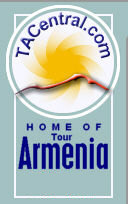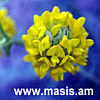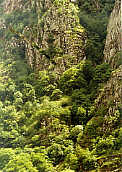 |
||||||||||||||||||||||||||||||||||
|
||||||||||||||||||||||||||||||||||
|
||||||||||||||||||||||||||||||||||
|
|||||||||||||||||||||||
 |
|||||||||||||||||||||||
| - | |||||||||||||||||||||||
|
||||
SOUTH (Sissian, Kapan, Meghri) OVERVIEW SISSIAN / GORIS / KAPAN and MEGHRI MINERALS, STONES, GEMS FLORA BIRDS OTHER FAUNA THERMAL AND MINERAL SPRINGS Overview Sissian District is noted for its vast stretch of alpine meadows, hemmed in by the Zangezur Mountain Range to the West and Southwest, the Karabakh Upland to the Northeast and the Bargushat Mountain Range to the South. The region was made from a mixture of volcanic and tectonic plate movements, with the "young" Karabakh Upland mountains (a mere 1.5 to 2 million years old) mixing with the old folks in the central plains and Bargushat mountain range (up to 60 million years in age). The Northern area is mostly made from volcanic lava (andesite, basalt), while the southern, jagged peaks are made from tuf, granite, marble and iron. Next to the Ararat Valley, Sissian's alpine zone has the richest stretch of fertile land, much of which was planted with wheat during Soviet times, particularly adjacent to Sissian City. Sissian even has a small museum devoted to wheat, located inside "Hotsatun", also Sissian's best restaurant. Ancestral Armenians first settled the area in the Mesolithic period, developing a specific culture that framed its rich soil and mined the area for iron, precious minerals and copper. Goris District shares the same mountainous borders as Sissian, but the Karabakh Uplands form the bulk of its landmass, with large limestone and basalt "needle stones" crowding the river canyons and mountainsides. Rising up to half a kilometer each, the needle stones are concentrated in the city of Goris (built in the 19th century by German Swiss and the De Gaulle family, who built the first gold and diamond mines in the region), and Khundzoresk. Goris lies deep inside a river gorge surrounded by pristine pine, oak and elm trees. Khundzoresk is called Armenia's "Lost Valley ". One of nature's splendors, Khundzoresk was a town built entirely from hundreds of caves carved since the early Bronze Age. The canyon is terraced, with homes interconnected by carved tunnels, in case of invasion by Persians, Seljuks or Turks. The caves were inhabited until as late as until 1980, when the last family moved out. Goris region also holds the Vorotan River Canyon, with its headwaters at two lakes in the Karabakh Uplands. By the time it reaches Goris District, the river has carved a canyon more than a kilometer deep and wide. Called Armenia's Grand Canyon, entire sub mountains lie in the center of the canyon, and millions of years of volcanic eruption and compression reveal strata of red, yellow, black, bronze, ochre, and white striated granite, basalt, tuf and marble. Tatev Monastery is perched on the edge of the canyon, near Devil's Gorge, a hot spring that gushes more than a million gallons of water a day. Hydroelectric plants lie at the base of the gorge, which supplied surplus power for the country until the 1989 energy blockade by Turkey and Azerbaijan. Additional development will continue to harness the waters of the Vorotan and its tributaries, contributing 10% to the country's needs. Just south of Goris City a vast forest begins, the second largest in Armenia. Stretching to the Iranian border at Meghri, the forest is teeming with wildlife. The are is covered with coniferous and deciduous forests that suddenly plunge into semi-desert land on the eastern borders. Evergreen, Large Oak, Dry Oak, and Georgian Oak fill the region with some of the most lush flora and fauna in the country. Kapan and Meghri Kapan and Meghri Districts are the most varied and stunning districts of the country, the rich forestland a part of a unique microclimate. While the river canyon may be hot and humid in summertime, moisture building up over Mts. Khustup and Ghazangiol blanket upper elevations with fog, bringing cooler temperatures and afternoon showers in the lower regions. The mountains also protect the region from the harshest winter weather. The mountaintops are covered with deep white snow, but the valley itself experiences suprisingly mild weather--the first freeze may not occur until January, and spring resumes by mid February. Blessed with pure natural resources, Kapan district holds a treasure trove of natural splendors. Not so easy to reach as other districts of the country, Kapan is also blessed by being relatively unvisited, so with an extra few days on your schedule, a sturdy car, and a wandering spirit, you can experience traditional life unhampered by tourist hoards. Kapan City lies at the opening of the Voghji River canyon onto the Arax River plain to the Southeast. Two of Armenia’s five tallest mountains lie in Kapan District. Mts. Kaputiugh (3904m/12,805f) and Ghazangiol (3829m/12,559f) lie on the Zangezour Range, which forms the Western border between Kapan District and Nakhichevan. The Bargushat Range forms the Northern border with Sissian and Goris Districts, while the Meghri Mountain Range lie between Kapan and Meghri Districts. The Eastern border with Azerbaijan is formed by ever decreasing mountains and hills that suddenly give way to the Giogian Steppe. Mt. Khustup, at 3201 meters (10,499 feet) is one of the most forbidding challenges for mountain climbers, with sheer walls of granite requiring expert climbing skills. Moderate to Advanced hiking is available throughout the district, and required to see some of the most interesting historic and natural sites. The town of Meghri, on the southern border with Iran lies in a Dry Sub-Tropic and Mediterranean zone, and has the longest growing season of all the districts. Here it is possible to find non-native palms, palmettos and citrus plants (lemon, lime), as well as native Mediterranean ferns, pomegranate and olive trees. Minerals, Stones, Gems Minerals found throughout Siunik include molibden, obsidian, quartz, barium, sulfur, Mercury, Barium, Sodium Chloride, gold, diamonds, copper, tin, silver and high-quality ceramic clay. Especially in Goris and Kapan there may be large deposits of precious gems (quarts, amethyst, carnelian, aquamarine, lapis lazuli and diamonds), but they are not currently being mined. Flora Kapan and Meghri Mountain Flora include Tulipa florensvyi, T. confusa: f. pink, f. red, f. yellow, Iris grossheimii, I. Paradoxa, I. Caucasica, I. Pseudocaucasica, I. Atropatana, Mesendera candissima, Colchicum zangezurum, Hyacintella atropatana, Fritillaria kurdica, F. armena, Orchis simma, O. schelvcornikovii, O. stvenii, O. coriphora, Steveniella satyroides, Cephalanthera epipactoides, Epipactis latifolia, Acantholimon fedorovii, Reseda globulosa, Cercis griffithii, Gladiolus szovitsii, G. atroviolaceus, G. italicus, Punica granatum (wild), Tournefortia siberia, Calendula persica. Northern Meghri and Kapan flora include Iris imbricata, Tulipa sosnovskyi, Fritillaria pinardii, F. armenia, Colchicum ninae, C. Szovitsii, Merendera raddeana, Crocus asamii, Corydalis persica, Ornithogalum sigmoideum, O. transcaucasicum, Genista transcaucasica, Mespilus germanica, Scilla mistscheukoana. Kapan and Vorotan flora include Iris lineolata, I. Paradoxa, I. Caucasica, Allium stamineum, Bellevalia paradoxa, B. longystila, Muscari atropatana, M. sosnovskyi, Tulipa Sosnovskyi, Punica granatum, Vinca Vitis sylvestris, Ficus carica (wild). Another treat from the flora kingdom in Siunik are the giant mountain mushrooms that appear in the spring and early summer. Huge white specimins are sold by the roadside near Sissian. They are wonderful treats, with a slightly nutty taste. Excellent cooking! Birds Other Fauna Thermal and Mineral Springs Kapan is covered with hundreds of mountain springs, among them two large hot carbonated springs. The water is naturally calcium carbonate, and a welcome respite for sore feet, muscles and bones. The two hot springs are located in the Eastern part of the district, one at Kapan City, and one by Nerkin Hand (about 12 kilometers below Kapan City on one of the most scenic roads in the district). The two heated springs are rated between 20-37 degrees C, or 68-95 degrees F, but our "soak test" gave them a rating on the upper temperature range. In Meghri District, Carbonated Sodium Cold Water Springs are located near Lichk, Aldara and Maratzami, Carbonated Calcium and Calcium warm water springs are located near Meghri, and Carbonated Calcium and Calcium warm cold springs by Maratzami.
Climate
Change Info Center-Armenia
INDIVIDUAL REPORTS
|
| |
Search | |
||||||



